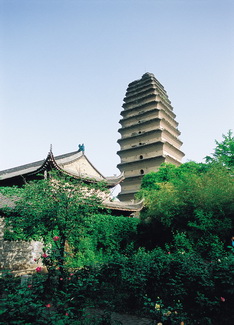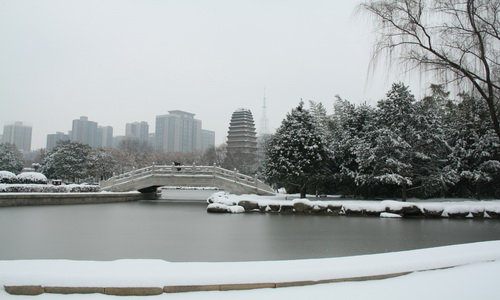Small Wild Goose Pagoda
Small Wild Goose Pagoda perched in Jianfu Temple is one of the two most significant Buddhist Pagodas in Xi'an. With more than 1,300 years history, it has stood as a witness to the introduction of Buddhism to central China via Silk Road in Tang dynasty. As an architectural wonder, the well-preserved 13-storied pagoda should not be missed by any history buffs for its survivals from dozens of severe earthquakes in Chinese history.
- Miracles
- Layout
- Function

Small Wild Goose Pagoda takes on an air of mystery since it survived dozens of severe earthquakes in Chinese history. The pagoda started to crack in the middle following a massive earthquake in 1487. However, the 1.1-feet-wide crack disappeared till another earthquake in 1521 followed by the upper two tiers of 15-storied pagoda crumbling away as a violent earthquake occurred in 1556. Nor is the earthquake over yet. Later, the pagoda made a magical combination in 1563. Its miraculous survival is exactly what makes the pagoda enjoy widespread popularity among the scholars and tourists around the world.
Small Wild Goose Pagoda is the oldest square brick pagoda with densely-arranged eaves in the Tang dynasty. The still intact 13-storied pagoda now stands 43.38 meters (142.32ft) high, with two upper tiers collapsed due to the violent earthquake in 1555AD. It was built out of the stone, consisting of the rectangular base, tower and underground palace. There are wooden ladders inside the pagoda, offering tourists a chance to climb up for the splendid bird's eye views over the old capital Xi'an. It is a gem of Buddhist architecture via the ancient Silk Road that witnessed the cultural communication between ancient China and India.
Small Wild Goose Pagoda was originally built to enshrine more than 400 Sanskrit Buddhist sutras and statues brought back from ancient India by the Buddhist monk Yijing. In order to popularize the Buddhist culture, he later translated and taught Buddhism with other distinguished masters like Vajrabodhi and Fazang in the state run Buddhist Sutra Translation Institute, who contributed greatly to the prosperity of Buddhism in China.
Built in 684, Jianfu Temple gained much popularity when Buddhism developed. It was the famous imperial Buddhist temple that frequented by the pilgrims from home and abroad. A great number of translated Buddhist scriptures made the temple known as one of the Three Buddhist Sutra Translation in Tang dynasties. However, frequent wars deadly destroyed nearly all the temples except the Small Wild Goose Pagoda that stands still. The stagnant Jianfu Temple brought back to life again until it was renovated in Ming and Qing dynasties. The ancient architectural complex on the central axis boasts Sutra Collection Tower, Bell Tower, Drum Tower and Nanshan Gate that highlight your Buddhism discovery as well.

Morning Bell Chime of the pagoda has been widely known as one of the Eight Famous Scenic Attractions in central Shaanxi plain. A giant iron bell stood 3.55 meters tall and weighed 10 tons, which can be traced back to the Jin dynasty in 1192. The old capital Xi'an starts to wake up with a chime sounded every morning. It is said that if you miss someone, you may strike the bell whose sound can be heard for many miles around. It is a magic bell considered symbols of good luck and happiness that is awaiting your discovery.
Xi'an Museum, a treasure house of ancient civilization, was officially opened in 2007. It was based on the design concept of round heaven and square earth. The 3-storied museum covers a display area of over 5,000 sq meters and collects more than 110,000 incomparable treasures, 10,000 of which are rated as Class-III cultural relics or above. A wide range of bronze wares, jade ware, stone sculpture, three-color glazed pottery, calligraphy and paintings unveils the glorious history of China, including Zhou (1046 BC - 256 BC), Qin (221 BC - 207 BC), Han (202 BC - 220 AD) and Tang (618 AD - 907 AD) dynasties.
Xi'an Museum centers on the basic display Ancient Capital Xi'an; that placed in the underground floor. The original Chang'an city's model takes you back to the glorious Tang dynasty 1,300 years ago. The first and second floor takes the thematic display Buddhist Statues and Ancient Jade as an extension, celebrated for its rich collections of exquisite statues, jade wares, potteries, calligraphy and paintings stretching over the past centuries.
Surrounding the museum is a beautiful park with a fewer tourists. It offers tourists a chance to feel the relaxing and serene ambiance away from the bustling city life. Here, you will see the elder practicing Tai Chi and their little kids running around. Stroll along the tree-lined walkways and take in the numerous ancient hitching posts for horses on both sides, each owning distinctive expressions and patterns. Either lovely gardens or peaceful lake is a great delight to spend your leisure time.
Free entry ticket could be obtained with ID card or passport.
Optional Fee for ascending Small Wild Goose Pagoda: CNY 30
Take bus No. 18, 21, 29, 32, 40, 46, 203, 204, 218, 224, 229, 258, 407, 410,508, 521, 618, 700, 713 or tourist bus No. 7, 8, 610 to Xiaoyanta Station (Small Wild Goose Pagoda) directly.
Take metro Line 2 and get off at Nanshaomen Station. Take the Exit A2. Walk towards west for about 500 meters to reach the northern entrance gate.









